On cold, grey, winter days in January and February a bright memory sometimes flutters into my mind, and I’m off on a daydream of a trip to see overwintering monarch butterflies in their mountain refuges in México in 2004, now eight years ago.
1 March, Monday. From the Terminal Poniente bus station in México City I took a first-class bus to Zitácuaro, Michoacán. The trip took about 3-1/2 hours. In Zitácuaro I went to the little local office of the WWF-México monarch butterfly conservation program and met with Israel Contreras, the field officer for the program, and Pedro Angeles, the forester. They gave me several pamphlets about monarch conservation work, and then Pedro took me over to the office of the Comisión Nacional de Áreas Naturales Protegidas (CONANP), the Mexican government agency that is responsible for the monarch butterfly reserves. They gave me lots more printed information, and a copy of the Programa de Manejo for the Reserva de la Biosfera Mariposa Monarcha. Then went back to the bus station and took a second-class bus from Zitácuaro to Angangueo, about an hour and fifteen minutes. I checked into the Hotel Don Bruno, and read about monarchs for the rest of the afternoon.
2 March, Tuesday. After breakfast I walked up to the center of town and found a lone taxi. The friendly driver, Pepe, agreed to take me to the Sierra Chincua reserve, wait for me there, and bring me back in the afternoon for a price of 200 pesos. The drive from Angangueo to the reserve entrance, just past the tiny settlement called Llano de las Papas, took about 40 minutes. The road was paved most of the way, but pot-holed, and went up, up, up, into cedar and pine, then fir. At the entrance was a collection of dusty shacks, some comedores and some selling recuerdos to turistas.
The entry fee to the reserve was paid to the Ejido Cerro Prieto, the communal land owners of this part of the mountain and the forest in which this core butterfly area is located. My assigned guide, Javier, had shoulder-length curly hair, wore a soccer shirt, jacket, well-worn jeans, and tennis shoes. Pepe, the taxi driver, was skeptical, maybe even a little worried about my security, and later told me he thought Javier, looked like “Geronimo, el Apache.” He was right, actually. But Javier turned out to be a knowledgeable, patient, and talkative guide, and I really liked him. We hiked up and up, to a high ridge, on a dusty trail badly eroded by horse traffic – lots of tourists hire horses to ride up here. The forest on the ridge was almost pure oyamel fir, Abies religiosa, with some pine lower down, and madroño on the rocky sections. The entrance to the reserve was at an elevation of about 3,000 meters, and the ridge maybe 3,300 meters.
The day was lovely, sunny, and breezy up on the ridge, and there were great views out over the valleys of the trans-volcanic belt, back toward Zitácuaro. Following old logging roads, now turned into hiking or horse tracks, we crossed over the ridge and down the steep north side. Javier showed me an area where the ground was covered with a thick layer of dead butterflies. This had been where the colony we were going to see had been in late January, when a really bad winter storm with freezing rain, ice, and eventually snow had struck. There had been a second colony here in this Sierra Chincua area, located just over the ridge on the south-facing side, but that colony had been pretty much completely killed by the storm, which must have hit from the south. After the storm, the survivors from that group moved over the ridge to the north side and joined the larger colony on that side. That colony had gradually been moving downhill, down a small drainage, to where pine and oak starts to mix in with the oyamel fir, and where we would find it after hiking about another 500 meters down the hill.
When we finally got to the edge of the main colony, a yellow rope stopped tourists from going farther and disturbing the butterflies. We had been hiking about 2-1/2 hours to get here, at a pretty brisk pace, without rest stops to speak of. A group of about a dozen Americans, mostly senior citizens, was the only other group there. They were obviously respectful ecotourists, well supervised by their guides, quiet and enchanted by the spectacle.
¡Increíble! ¡Maravilloso! In the shade, the lower branches of the tall oyamel firs had butterflies hanging in heavy clusters, almost the shape of giant paper-wasp nests, weighting them down. In these clusters the butterflies all had their wings folded, showing the pale undersides only, so they were dull and grey in color, in the shade. Any sunny tree branch, small tree, or bush was full of sunning butterflies, mostly with wings spread open and orange. The dark fir branches looked like spruces and firs do in Colorado when they catch yellow aspen leaves in the fall, mostly bright and bedecked. The sunny sides of tree trunks had rows and rows of hundreds of butterflies, warming themselves. The air was full of butterflies flying in all directions, hundreds and hundreds everywhere you looked. Against the blue sky they were layered from low and close, to high above the treetops, either dark silhouettes, or bright spots of orange if flying in the sun. There were swirls and swarms, flutters and clouds, millions of monarchs, literally. Some were nectaring on a mint with small purple flowers that was blooming on the ground here. Some were drinking at a small stream, and others drowning or drowned in it. We were just on the edge of the colony, Javier said – the middle of it was probably another 300 meters downhill, he estimated. I tried to imagine what it would be like to be in the middle of the colony, rather than just looking in from the edge – I imagined something like looking at the Milky Way Galaxy from the edge rather than the middle – in this case, a galaxy of butterflies.
Fairly often a mating pair would fall fluttering out of the sky and plop down beside me. Most were male-female pairs, the males either already hooked up abdomen-tip to abdomen-tip with the female, or struggling to attach. Sometimes two males fell to the ground, struggling to hook up before they figured out it wouldn’t work. Sometimes an extra male fell with a male-female pair, the third male trying to take her away from the first male. The local guides seemed to enjoy this: “el amor de las mariposas.” One said “las mariposas no tienen corazones como nosotros, pero en sus corazonitos, es el amor” – “the butterflies don’t have hearts like us, but in their little hearts, this is love!” After a struggle to get well-attached on the ground, frequently the male would fly, carrying the female up into the sky. She would relax and arch her abdomen back, wings folded, suspended upside down, being pulled by those erotic orange wings into the blue cielo, up to a sunny branch where mating could continue at leisure.
By the time I left, saturated and well-nourished for the time being with magical images of monarchs everywhere, there was a fairly brisk breeze in the fir-tops, and it seemed to carry swirls of butterflies. I was again reminded of watching aspen leaves blow off the trees last October in the Colorado mountains. Only here the butterfly leaves didn’t fall down, but swirled and whirled in the sun, staying at the same level and eventually going back to re-attach to the branch, as if gravity was powerless, time was running backward, leaf-fall reversing itself.
3 March, Wednesday. After another big breakfast at the Don Bruno, I went outside and negotiated with one of the guys waiting with their pickup trucks to take me to the other reserve, El Rosario, for 150 pesos one-way. The driver, Diego, was an open, talkative guy, and he promised to show me where I could catch a local bus back down at either 1 PM or 3 PM, for only a few pesos. It was another clear, sunny morning, again promising perfect weather for seeing monarchs. The road to El Rosario from Angangueo was steep, and rough dirt – inches deep in dust, in some places, in fact. At one hairpin turn in the road we passed a small shrine — this must be “La Virgin de las Mariposas,” I decided – with big bouquets of fresh calla lilies.
The views down the valleys were beautiful, but many of the fields along this road were cleared on very steep slopes. I didn’t see much gullying and obvious erosion, but it’s hard to believe that slopes this steep can be sustainably farmed.
The entrance at El Rosario was bigger and busier than at Sierra Chincua – this reserve has been open to tourists for something like 20 years, as compared to only 7 years for Sierra Chincua, so it is much more visited. The roped-off observation area was only about a thirty-minute walk from the reserve entrance. Most of the people here on this warm morning were Mexican senior citizens. They were endearing, with their walking sticks, hobbling up and down and chatting, getting their pictures taken with butterflies all around them or landing on their heads. There were maybe 50 people in the small observation area – a much more crowded and noisy scene than at Sierra Chincua, but fun to watch in its own way. A sort of butterfly party, a fiesta de las mariposas.
There were far fewer butterflies here, although still a lot. This colony is a little higher than at Sierra Chincua, and my guide, Sergio, said that the storm on January 30th dumped 20 centimeters of snow here. About 80% of the butterflies here were killed by that storm, he said. Chip Taylor, a monarch expert from the University of Kansas, said that he thought 98% of the butterflies in this El Rosario colony died this winter.
A few years earlier, in 1998, I think, there were also bad winter storms that killed lots of butterflies. But, within a year, numbers in wintering colonies had mostly recovered. Breeding conditions during the summer have a big influence on the size of the wintering colonies, and they were apparently good enough to let the decimated winter population recover. Chip Taylor worried that these winter storms are becoming more common. One of the predictions of global warming models is more winter precipitation at these latitudes in México, and here in Michoacán that may mean a greater chance of freezing rain, or ice or snow storms. The colonies are flexible to a certain extent, choosing different sites in different years, and sometimes splitting into several colonies in the same area. However, according to Taylor, 60-70 percent of all eastern North American monarchs overwinter either in Sierra Chincua or El Rosario – all of the 18 or so other sites known in México only host 30 or 40 percent of the monarchs. In these two most important areas there are sometimes two or three colonies in each, sometimes only one.
One of the things monarchs need to survive in the long run is an area of forest large enough to allow the colonies to flexibly select different overwintering sites from year to year, based on climatic cues that they somehow pick up that year – or to move during the winter if a bad storm does hit. No one seems to know how, exactly, they choose a site for a colony within the general area of Sierra Chincua, El Rosario, or wherever. And to maintain the possibility of having a big enough forest area to move around in, in the face of possible global-warming-induced climate changes, the butterflies need the help of local people.
The WWF México project, and other monarch conservation initiatives, are supporting tree nurseries and reforestation efforts to maintain and increase the area of oyamel fir forests, as well as encouraging the development of sustainable monarch tourism. Monarch conservation can only work here if it contributes to meeting local social and economic needs. If the people I met – like Pepe, Diego, and my guides Javier and Sergio – are any indication, I think local people are committed to conserving the monarchs, sharing the amazing spectacle with visitors from all over the world, and improving their lives through jobs as guides, forest guards, and work in forest restoration.
If you enjoyed this post, you might also be interested in my previous posts on monarchs:
For more photos of monarchs in México, see the Gallery page:
Readers of Spanish may also be interested in my report, La Reserva de la Biosfera Mariposa Monarca y el papel del comportamiento de la gente en su conservación, prepared for WWF-México and USAID-Mexico. The report is also listed in the Bruce Byers Library.
Links for additional information:
- WWF México Monarch Butterfly Program
- Monarch Watch
- Cape May Bird Observatory Monarch Monitoring Project
- Journey North Monarch Migration Tracking Project




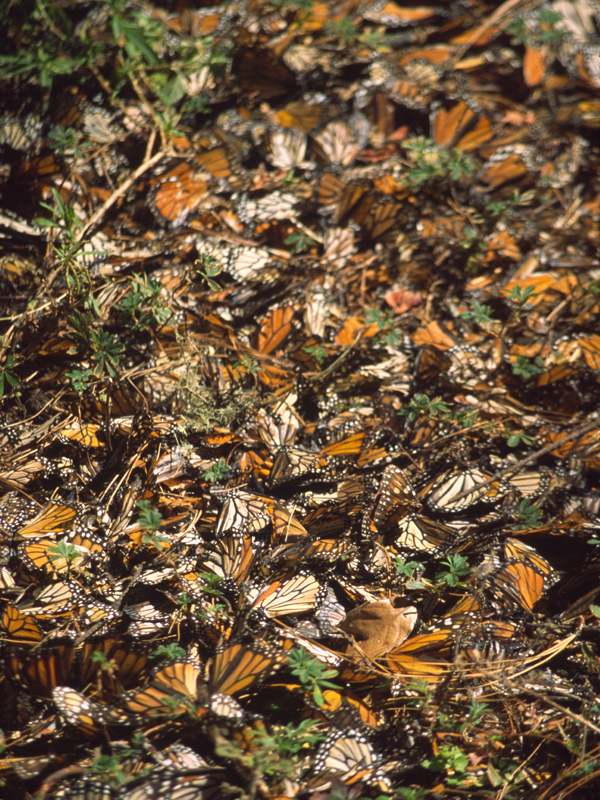
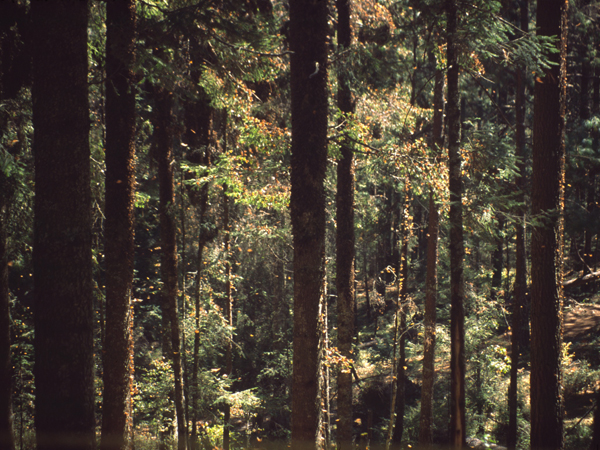
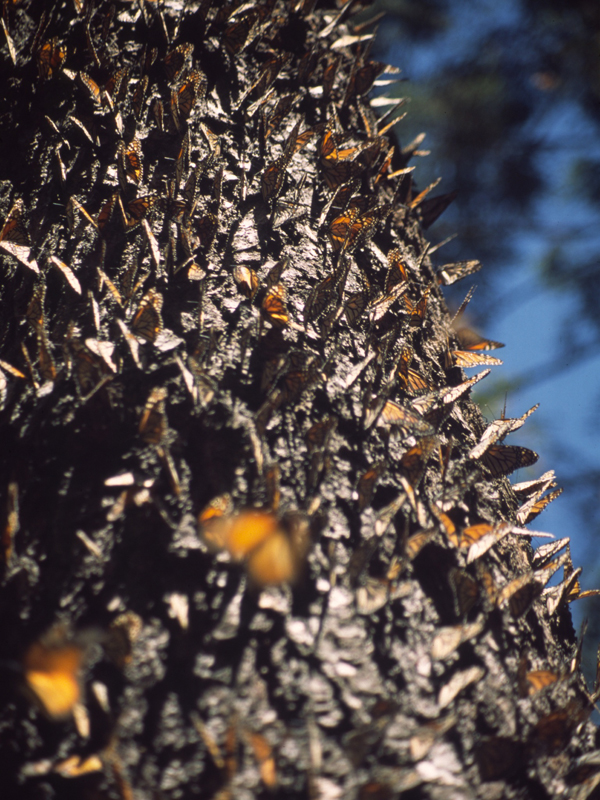
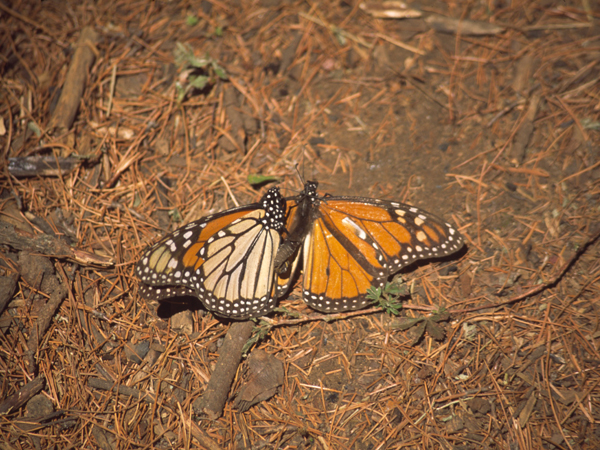


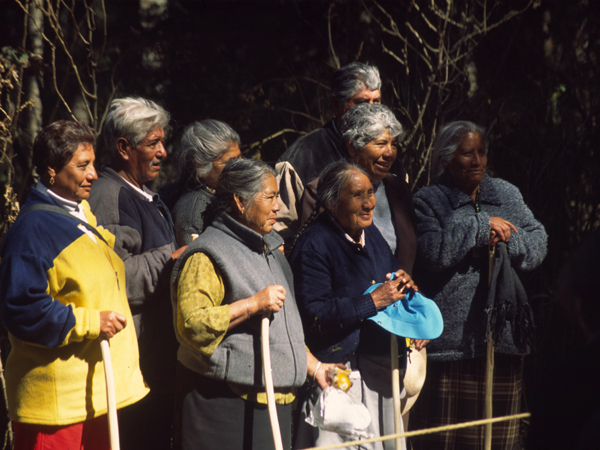







October 24, 2012 9:17 pm
[…] A Pilgrimage to the Monarch Butterfly Overwintering Refuges in Michoacán, México […]
May 19, 2013 7:34 pm
[…] For earlier stories about monarch butterflies, read Field of Dreams of Monarchs and A Pilgrimage to the Monarch Butterfly Overwintering in Michoacan Mexico. […]
November 8, 2013 2:50 am
[…] A Pilgrimage to the Monarch Butterfly Overwintering Refuges in Michoacan, Mexico […]